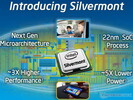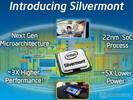Intel Atom Z3736G vs Intel Atom Z3680D
Intel Atom Z3736G
► remove from comparison
The Intel Atom Z3736G is a power-efficient quad-core SoC for tablets (Android or Windows). It is clocked at 1.33 - 2.16 GHz and part of the Bay Trail-T platform. Thanks to the specially optimized 22nm low-power design process (P1271) with Tri-Gate transistors, performance and energy efficiency have been significantly improved compared to its predecessor. In contrast to the Z3736F, the Z3736G only offers a 32 bit single-channel DDR3L-RS-1333 memory controller (max. 1 GB, 5.3 GB/s).
Architecture
The processor cores are based on the new Silvermont architecture, which is an out-of-order design for the first time. The increased utilization of the pipeline and many other improvements (optimized branch prediction, increased buffers, and enhanced decoders) have increased the performance per clock by about 50 percent. At the same time, however, the Hyper-Threading feature of the previous generation has been removed. Other major additions are the support for new instruction set extensions such as SSE 4.1 and 4.2 as well as AES-NI (depending on the model).
Performance
Thanks to 4 CPU cores and the improved performance per clock, the Z3736G is significantly faster than previous Intel Atoms like the Z2760. Depending on the benchmark, the Z3736G competes with AMDs Kabini APU A4-5000. For everyday tasks such as Internet or Office the performance is adequate, but not for very complex Windows software or modern games. Compared to ARM SoCs for Android systems, the Z3736G is placed in the upper mid-range segment.
Graphics
The HD Graphics (Bay Trail) is based on the Intel Gen7 architecture, which supports DirectX 11 and is also found in the Ivy Bridge series (e.g. HD Graphics 4000). With only 4 EUs (Execution Units) and a relatively low clock speed of up to 646 MHz, the GPU is even slower than the HD Graphics (Ivy Bridge). Therefore, only older and less demanding games (like simple Android titles) will run fluently. However, video acceleration and other multimedia applications are no problem for the chip.
Power Consumption
The entire SoC is rated at an SDP of 2.2 W, which indicates a TDP of less than 4 W. Thus, the chip can be used in passively cooled tablets.
Intel Atom Z3680D
► remove from comparison
The Intel Atom Z3680D is a power-efficient dual-core SoC for Windows and Android tablets. It is clocked at 1.33 - 2.0 GHz and is part of the Bay Trail-T platform. Thanks to the specially optimized 22nm low-power design process (P1271) with Tri-Gate transistors, performance and energy efficiency have been significantly improved compared to its predecessor. In contrast to the Z3680, the Z3680D offers a different memory controller and a lower display resolution.
Architecture
The processor cores are based on the new Silvermont architecture, which is an out-of-order design for the first time. The increased utilization of the pipeline and many other improvements (optimized branch prediction, increased buffers, and enhanced decoders) have increased the performance per clock by about 50 percent. At the same time, however, the Hyper-Threading feature of the previous generation has been removed. Other major additions are the support for new instruction set extensions such as SSE 4.1 and 4.2 as well as AES-NI (depending on the model).
Performance
Thanks to the improved performance per clock, the Z3680D is faster than previous Intel Atoms like the Z2760. Presumably, the Z3680D even competes with AMD APUs like the AMD A4-4355M. For simple everyday tasks such as Internet or Office the performance is adequate, but not for complex software or modern games.
Graphics
The HD Graphics (Bay Trail) is based on the Intel Gen7 architecture, which supports DirectX 11 and is also found in the Ivy Bridge series (e.g. HD Graphics 4000). With only 4 EUs (Execution Units) and a relatively low clock speed of up to 688 MHz, the GPU is even slower than the HD Graphics (Ivy Bridge). Therefore, only older and less demanding Windows games will run fluently. However, video acceleration and display resolutions up to 1920 x 1200 pixels are no problem for the chip.
Power Consumption
The entire SoC should be rated at an SDP of about 2 W, which would indicate a TDP of less than 4 W. Thus, the chip can be used in passively cooled tablets.
| Model | Intel Atom Z3736G | Intel Atom Z3680D | ||||||||||||||||||||||||||||||||||||||||||||||||||||||||||||||||||||||||||||||||||||||||||||||||||||||||||||||||||||||||||||||||||||||||||||||||
| Series | Intel Atom | Intel Atom | ||||||||||||||||||||||||||||||||||||||||||||||||||||||||||||||||||||||||||||||||||||||||||||||||||||||||||||||||||||||||||||||||||||||||||||||||
| Codename | Bay Trail-T | Bay Trail-T | ||||||||||||||||||||||||||||||||||||||||||||||||||||||||||||||||||||||||||||||||||||||||||||||||||||||||||||||||||||||||||||||||||||||||||||||||
| Series: Atom Bay Trail-T |
|
| ||||||||||||||||||||||||||||||||||||||||||||||||||||||||||||||||||||||||||||||||||||||||||||||||||||||||||||||||||||||||||||||||||||||||||||||||
| Clock | 1330 - 2160 MHz | 1330 - 2000 MHz | ||||||||||||||||||||||||||||||||||||||||||||||||||||||||||||||||||||||||||||||||||||||||||||||||||||||||||||||||||||||||||||||||||||||||||||||||
| L1 Cache | 224 KB | 112 KB | ||||||||||||||||||||||||||||||||||||||||||||||||||||||||||||||||||||||||||||||||||||||||||||||||||||||||||||||||||||||||||||||||||||||||||||||||
| L2 Cache | 2 MB | 1 MB | ||||||||||||||||||||||||||||||||||||||||||||||||||||||||||||||||||||||||||||||||||||||||||||||||||||||||||||||||||||||||||||||||||||||||||||||||
| Cores / Threads | 4 / 4 | 2 / 2 | ||||||||||||||||||||||||||||||||||||||||||||||||||||||||||||||||||||||||||||||||||||||||||||||||||||||||||||||||||||||||||||||||||||||||||||||||
| TDP | <4 Watt | 4 Watt | ||||||||||||||||||||||||||||||||||||||||||||||||||||||||||||||||||||||||||||||||||||||||||||||||||||||||||||||||||||||||||||||||||||||||||||||||
| Technology | 22 nm | 22 nm | ||||||||||||||||||||||||||||||||||||||||||||||||||||||||||||||||||||||||||||||||||||||||||||||||||||||||||||||||||||||||||||||||||||||||||||||||
| Socket | UTFCBGA592 | |||||||||||||||||||||||||||||||||||||||||||||||||||||||||||||||||||||||||||||||||||||||||||||||||||||||||||||||||||||||||||||||||||||||||||||||||
| Features | Intel HD Graphics (Bay Trail, 313 - 646 MHz), Quick Sync, Wireless Display, Clear Video HD, Intel 64, SSE 4.1, SSE 4.2, AES-NI, Secure Key, Anti-Theft, Identify-Protection, max. 1 GB Single-Channel (32 Bit) DDR3L-RS 1333, Quick Sync | Intel HD Graphics (Bay Trail, max. 688 MHz), Intel 64, SSE 4.1, SSE 4.2, AES-NI, max. 2 GB Single-Channel DDR3L-RS 1333, Quick Sync | ||||||||||||||||||||||||||||||||||||||||||||||||||||||||||||||||||||||||||||||||||||||||||||||||||||||||||||||||||||||||||||||||||||||||||||||||
| iGPU | Intel HD Graphics (Bay Trail) (313 - 646 MHz) | Intel HD Graphics (Bay Trail) (313 - 688 MHz) | ||||||||||||||||||||||||||||||||||||||||||||||||||||||||||||||||||||||||||||||||||||||||||||||||||||||||||||||||||||||||||||||||||||||||||||||||
| Architecture | x86 | x86 | ||||||||||||||||||||||||||||||||||||||||||||||||||||||||||||||||||||||||||||||||||||||||||||||||||||||||||||||||||||||||||||||||||||||||||||||||
| $20 U.S. | ||||||||||||||||||||||||||||||||||||||||||||||||||||||||||||||||||||||||||||||||||||||||||||||||||||||||||||||||||||||||||||||||||||||||||||||||||
| Announced | ||||||||||||||||||||||||||||||||||||||||||||||||||||||||||||||||||||||||||||||||||||||||||||||||||||||||||||||||||||||||||||||||||||||||||||||||||
| Manufacturer | ark.intel.com |
Benchmarks
* Smaller numbers mean a higher performance
1 This benchmark is not used for the average calculation


 Deutsch
Deutsch English
English Español
Español Français
Français Italiano
Italiano Nederlands
Nederlands Polski
Polski Português
Português Русский
Русский Türkçe
Türkçe Svenska
Svenska Chinese
Chinese Magyar
Magyar